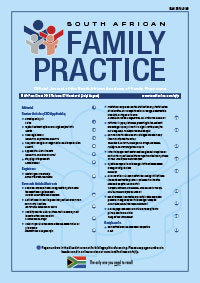Prostate cancer profile and risk stratification of patients treated at Universitas Annex Department of Oncology, Bloemfontein, Free State, during 2008 to 2010
Keywords:
prostate cancer, risk group, stratification, profile, high risk
Abstract
Background: Prostate cancer commonly occurs in older men. Since TNM staging excludes prostate-specific antigen (PSA) level and Gleason score, patients with prostate cancer are divided into risk groups when deciding on treatment options. This study determined the profile and risk stratification of patients with prostate cancer treated at the Department of Oncology, Universitas Annex in Bloemfontein, Free State, during 2008 to 2010. Methods: This was a cross-sectional study with retrospective data collection. Information was gathered from 497 patient files on age, race, residence, Gleason score, PSA level, TNM stage, and initial treatment. The patients’ risk group was determined from their Gleason score, PSA level, and T stage. Results: Patients were mostly (45.7%) between 65 and 75 years of age and 72.8% were in the black race group. The largest percentage of patients had a Gleason score of 8 to 10 (43.7%), PSA level > 20 ng/ml (67.9%), and a T stage ≥ T3 (62.3%). Almost half of the patients (48.7%) had stage IV disease and 38.4% received palliative hormonal therapy as initial treatment. The majority of patients (82.5%) fell into the high risk group. Conclusions: The majority of patients in each age group fell into the high risk group, which means that these patients were at a higher risk of developing metastatic prostate cancer. We recommend better education of our patient population and local clinic staff, so that people in the community can understand the prevalence of the disease, the symptoms and effect of the cancer, and that it is treatable if detected early. (Full text available online at www.medpharm.tandfonline.com/ojfp) S Afr Fam Pract 2015; DOI: 10.1080/20786190.2014.993859
Published
2015-08-26
Section
Research Articles
By submitting manuscripts to SAFP, authors of original articles are assigning copyright to the South African Academy of Family Physicians. Copyright of review articles are assigned to the Publisher, Medpharm Publications (Pty) Ltd, unless otherwise specified. Authors may use their own work after publication without written permission, provided they acknowledge the original source. Individuals and academic institutions may freely copy and distribute articles published in SAFP for educational and research purposes without obtaining permission.

